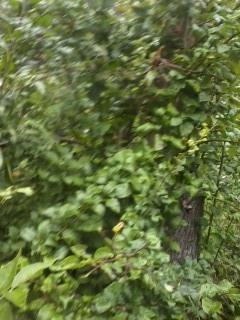jujubemulberry ,
I think that’s a very good point you brought up and I’m glad you did. Your right that a true Bradford pear are very short lived. No one really knows how long callery rootstock like my oldest will live. These are some of the cultivated variants of callery listed below. Bradford typically are lost to storms but not all of the other ornamental pears have that flaw. The wild callery are durable and I actually have friends with some on their property that are very old. A nearby town a tree stands that a friend dug seedlings from 30 years ago and the tree is still there. What is it? I don’t know for sure but I suspect its a hybrid. The urbanforestnursery made these observations about callery varieties they posted to their website
" 'Aristocrat’ A wider form tree with branches at right angles to the central leader. The distinct characteristics of the leaf are its wavy edges. Fall color is not as reliable as others, but if you have the crown space, the Aristocrat is a fine selection. Older trees are reported to reach 40’ high by 25’ wide.
‘Autumn Blaze’ This tree is not recommended unless the site is very protected from wind. Although the form is round and the color is better than most of the pears, the limbs are incredibly brittle. Even if you get trees to the site undamaged during handling and shipping, winds will tear the tree apart for many years. From my experience, this one should be listed along with the original Bradford Pear.
Cleveland Select Flowering Pear’Chanticleer’ (same as ‘Select’, ‘Cleveland Select’, and ‘Stone Hill’). The most popular, as well it should be, with its upright pyramidal growth, relatively good branch structure, and consistent qualities listed above. This cultivar was reported to reach 35’ high by 16’ wide after 15 years.
‘Cambridge’ Appears to have cleaner, more regular ascending limbs, smooth bark, with orange fall color. It is narrow like "Chanticleer’.
‘Capital’ Even narrower than the ‘Chanticleer’, so for a narrow space, this is the better choice. I have found the branch structure not to be as consistent or attractive in its winter show. The tree is said to grow to 32’ high by 8’ wide in 15 years.
‘Jack’ This tree is the smallest pear cultivar I have seen, growing to no more than 15’ tall by 10’ wide. This tree has a dense branch structure and very slow growth. Call for it more as spaces for trees get shorter and tighter. Check out the Jack Pear tree profile here.
‘Redspire’ This tree has a moderately pyramidal form, less than Chanticleer. I have found it to have some brittleness, thus somewhat susceptible to wind breakage.
'Bradfords’ are known for their extremely tight crotches and severe splitting apart as they mature. This cultivar was the first selection of Pyrus calleryana. Most of the older Bradfords have literally split apart. Avoid this one along with the ‘Autumn Blaze’ " as found here Tree Profile for the Flowering Pear - Urban Forest Nursery, Inc.
In Kansas I frequently go observe wild callery and other types of pears. A friend mentioned a location with wild pears on his property and asked me to hike out there and determine what they were. The pears were as expected callery pears but that was when the surprises started. Typically the species has pea sized fruit. These trees for the most part were typical callery pears except for one tree which is shown in this photo. 
As mentioned the above tree is no Bradford nor is it short lived. It’s been there around 25 years they knew of. They bought the property then to deer hunt and the deer eat this fruit. Here is another wild pear with more typical fruit as a comparison below.

Oddly I found non producing and producing pears in this area well over 100 years old.




